- PARIS_FRANCE
Paris is "The City of Light" or "La ville lumière"


The nickname for Paris is "The City of Light" or "La ville lumière"

Map showing most important tourist locations in Paris.


-VIDEO :Paris Vacation Travel Video Guide • Great Destinations(2015)
- I Love Paris - Woody Allen - Ella Fitzgerald :


Panorama of the 16th arrondissement of Paris and western suburbs from the Eiffel Tower

)
-VIDEO:Paris, France
-VIDEO:France Vacation Travel Video Guide (2013)

Paris in 1763, by Nicolas-Jean-Baptiste Raguenet, A View of Paris from the Pont Neuf, Getty Museum
Horse-drawn carriages and strolling couples make their way across the Pont Neuf, one of the oldest bridges in Paris. Boats are tied up on both sides of the Seine River, a heavily traveled thoroughfare. In the center, behind an iron fence, stands an equestrian statue of Henri IV. On the right bank of the river is the Louvre, the national museum and art gallery of France. The dome of the Hôtel des Invalides can be seen on the left bank in the distance. Jean-Baptiste Nicolas Raguenet specialized in views of Paris and owned a small shop for their sale in the rue de la Colombe on the Ile de la Cité. This view of Paris in the 1700s and its companion piece, View of Paris with the Ile de la Cité, were probably painted for an English patron, Lord Holland.

Pierre-Antoine Demachy. The Festival of the Supreme Being, held on 8 June 1794 on the Champs de Mars, was an official celebration of Cult of Reason presided over by Robespierre. On July 27, he was arrested and sent to the guillotine, ending the Reign of Terror.
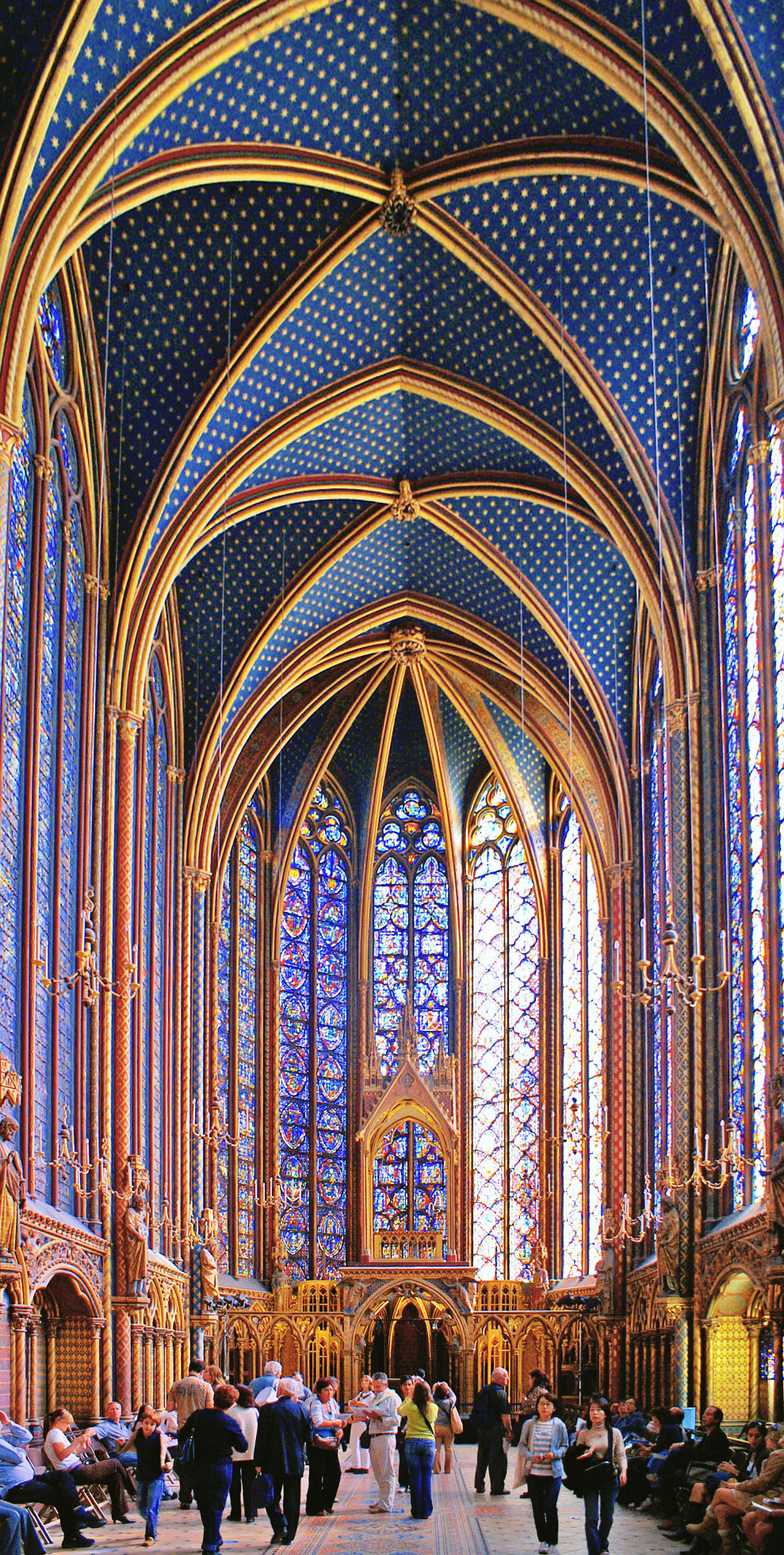
Sainte-Chapelle, the chapel of the former royal palace on the Île de la Cité, flooded by light through the stained glass windows, is a masterpiece of the Gothic style. (13th century)


Plus de 9 millions d'habitants avec la banlieue
La ville couvre 105 km², et avec la banlieue environ 2 000km²
La ville est divisée en 20 arrondissements.



 Members of the French Republican Guard Cavalry regiment take part in the Bastille Day parade on Champs-Elysees avenue in Paris on July 14, 2013 in Paris
Members of the French Republican Guard Cavalry regiment take part in the Bastille Day parade on Champs-Elysees avenue in Paris on July 14, 2013 in Paris



2013_06_14_The Arc de Triomphe, Paris.
The Arc de Triomphe de l'Étoile is one of the most famous monuments in




-VIDEO :HD Seine Cruise Clips



La PLUS PETITE MAISON de Paris mesure 1,10m de large et 5,15m de haut, vous la trouverez au 39 rue du Château d’eau dans le 10ème,

Petit Palais facade

La Seine et ses affluents (The Seine and its tributaries).

Petit Palais hall

French: Les Quatre Saisons




“L'Immortalité devançant le Temps” (Immortality outstripping Time) Quadriga by Georges Récipon, Grand Palais Paris
-VIDEO :◄ Grand Palais, Paris [HD] ►
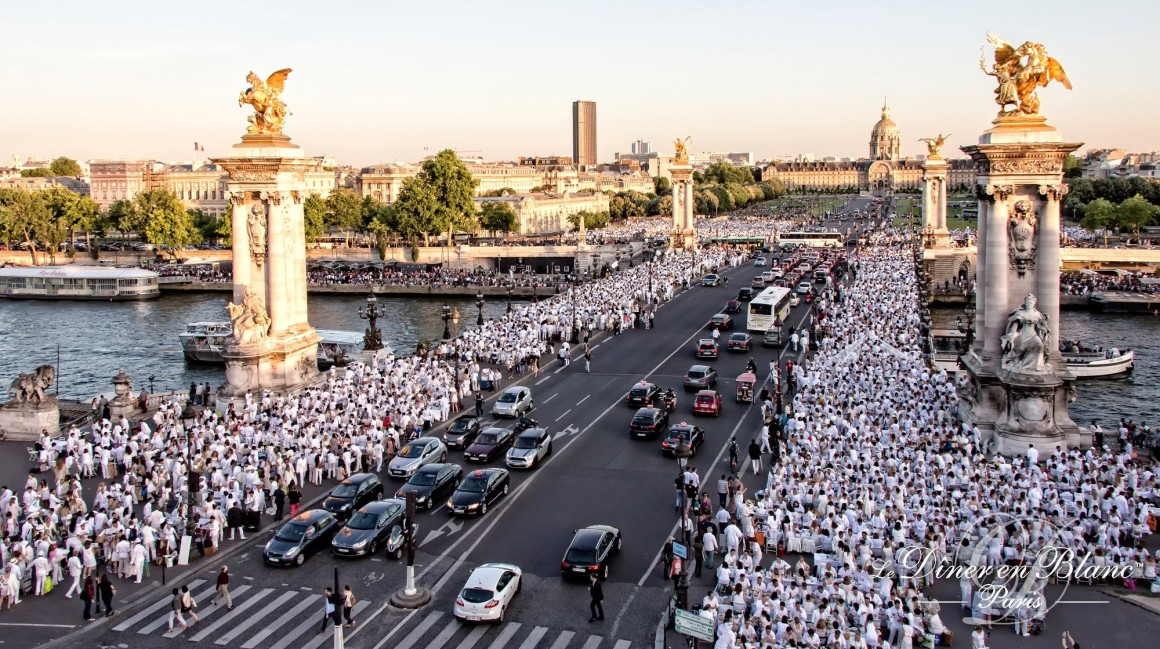
-VIDEO :Le Dîner en Blanc de PARIS 2014

This 1/4 scale Statue of Liberty stands on an island, much like our Statue of Liberty on Liberty Island (then called Bedloe's Island) in New York Harbor, a gift from the people of France to the United States.
-VIEW : Il y a 5 Statues de la Liberté à Paris !_Vous connaissez celle de New-York qui fait 46,05 mètres (93 mètres socle inclus), mais savez-vous qu’il y a pas moins de 5 répliques originales de la Statue de la Liberté à Paris ? Si, si on vous jure !


Opera House

The Galeries Lafayette_

-Dinner at Les Noces de Jeannette_Paris
Les Noces de Jeannette_Paris


2009-06-04_-Dinner @ " Les Noces de Jeannette "


2009_06_04_Dinner in Paris _France


-VIDEO :L'escargot
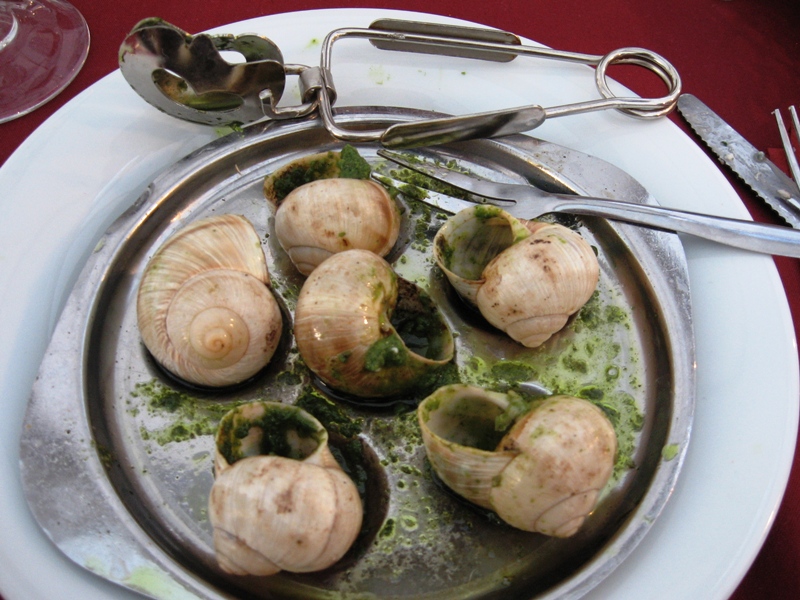


2009_06_04_Dinner in Paris _France




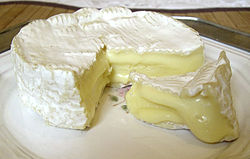

Café Les Deux Magots in Saint-Germain-des-Prés,Paris 6ème , France.

P A R I S


Eiffel Tower by the Seine river, Paris, 2 March 2014





360° virtual tour of Trocadero - Tour Eiffel









The two impressive buildings on either side of this picture are, on the left, the Hotel de Crillon, a classy high-end hotel, and on the right, the headquarters of the French Navy. Between them, at the top of the rue Royale, you can see the classical façade of the Madeleine Church.
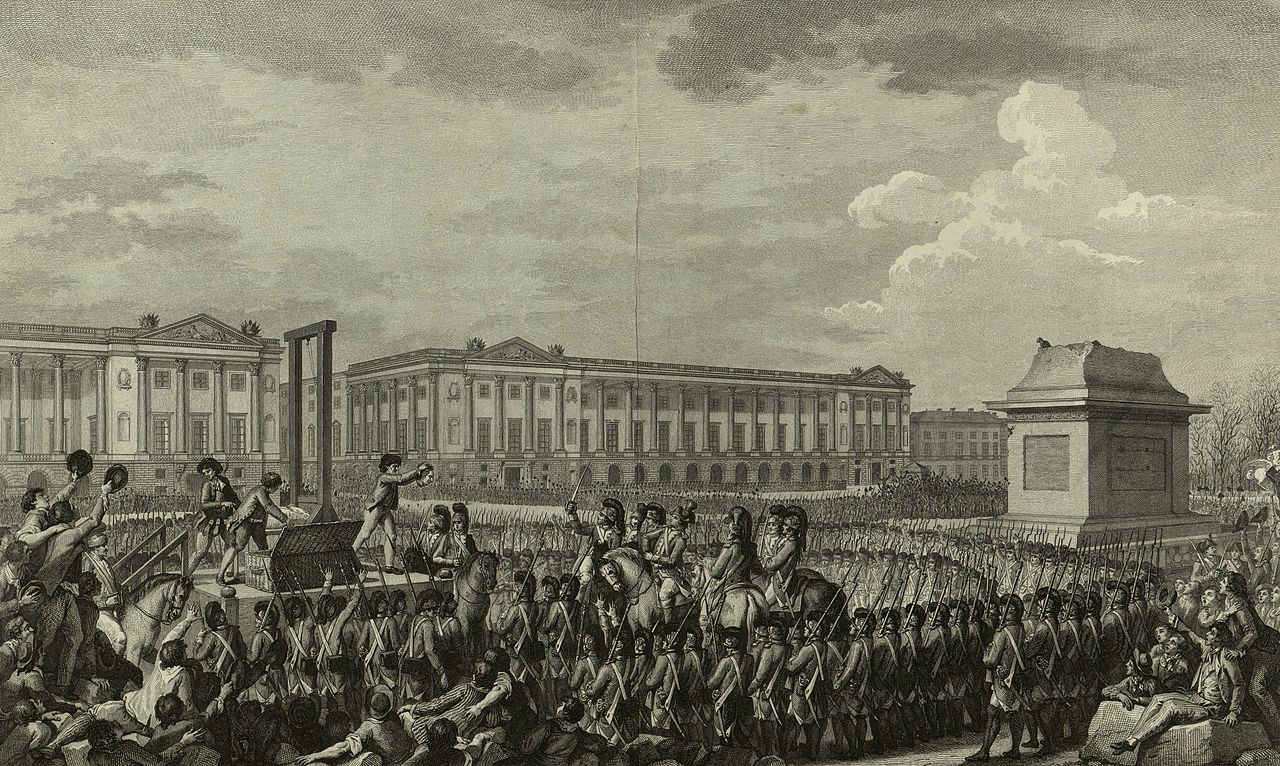 The execution of King Louis XVI on Place de la Révolution. The rolling of drums covered his final words, which could not be heard by the crowd.
The execution of King Louis XVI on Place de la Révolution. The rolling of drums covered his final words, which could not be heard by the crowd.
Journée du 21 janvier 1793 la mort de Louis Capet sur la place de la Révolution : présentée à la Convention nationale le 30 germinal par Helman
 The execution of Robespierre and his supporters on 28 July 1794. Note: the beheaded man is not Robespierre, but Couthon: Maximilien Robespierre is shown sitting on the cart, dressed in brown, wearing a hat, and holding a handkerchief to his mouth. His younger brother Augustin is being led up the steps to the scaffold.
The execution of Robespierre and his supporters on 28 July 1794. Note: the beheaded man is not Robespierre, but Couthon: Maximilien Robespierre is shown sitting on the cart, dressed in brown, wearing a hat, and holding a handkerchief to his mouth. His younger brother Augustin is being led up the steps to the scaffold.

Paris is "The City of Light" or "La ville lumière"

Tableau de Georges Garen peint en 1889 intitulé « Embrasement de la Tour Eiffel pendant l’Exposition universelle de 1889.

La Tour Eiffel from North of the Trocadero, 1889
| Why is Paris called the City of Light? Paris is known as the City of Light. How did it get this nickname? There seems to be two reasons | |
During the Age of Enlightenment in the Eighteenth century it became a centre of education, learning and philosophy. So it was seen as an "enlightened" place to be.
In the nineteenth century, Paris was one of the first cities to adopt street lighting, gas lamps in the Champs Elysées in 1829 and electric lights for its Great Exhibition of 1889. So it really was a city of light among all the other cities that were still in the dark!
Having the city lit at night was a great innovation. It meant that people were now able to undertake leisure activities after dark. It made the streets safer. Instead of staying at home, people began to use the time after night fell in a productive way. The Expo stayed open until midnight. It marked the beginning of modern urban life.
http://www.caloundracity.asn.au/Francofiles/paris/paris_light.htmlPhoto Sphere - Oct 2015 : |
Florence Coste et Julien Dassin
Map showing most important tourist locations in Paris.
| A Little History of Paris. | |
The ancient name for France is Gaul. More than two thousand years ago, a tribe of Gauls called the Parisii settled on two little islands in the Seine in what is now the centre of Paris and founded a little fishing village. We know this area today as the Ile de la Cité, and it is where Notre Dame is located. The Romans, led by Julius Caesar, conquered the area in 52BC, They made the Parisii fishing settlement into a regional centre and called it "Lutetia" (or Lutèce in French.) They also created a a suburb on the Left Bank in the “Latin Quarter”. Today you can visit the Musée de Cluny and see the remains of a Roman bathhouse and its "frigidarium" or cold bath. You can also see many Roman artefacts including fishing and trading canoes in the Musée Carnavalet (or Museum of Paris). Paris of the Middle Ages During the 5th to 10th centuries Paris must have been a dangerous place to live. Its residents had to endure fires, continuous Viking raids, and seiges. King Clovis renamed the Roman Lutetia, Paris, after the tribes who originally lived there and made the city his capital. It became the capital of France just before the year 1000 when Hugh Capet, the Count of Paris, became the King of France. The Ile de la Cité gradually became too small for the city, as the number of its inhabitants grew, and its area expanded on both sides of the river. The original centre, on the islands, was the government and religious centre, and the Cathedral of Notre Dame de Paris was begun just after 1100. The Left Bank became the centre for learning, and it was here that in the 13th century, the Sorbonne University was founded, one of the earliest Universities in the world. The marshes on the Right Bank were drained and the land was reclaimed. The centre for commerce and finance was located there. Today, this area is still called "Les Marais" which means "marshes" in French. About this time, the Louvre was built, as a fortress by the River Seine. By the 15th Century, Paris had become one of the major cities in Europe. Paris of the 19th century Paris as we know it today was created by Baron Haussmann during the mid-nineteenth century. He decided that the slum areas of the city needed to be removed so that the city could be modernised. Baron Haussmann deliberately destroyed the old houses and slums dating back to the middle ages. He had a vision that the Arc de Triomphe should be focus point for his new, modern city. Consequently he designed twelve main avenues to radiate outwards from the Arc. He called the square "Place de l'étoile" which means "Star Square." On the right is a diagram of the the avenues that surround the Arc de Triomphe in the 8th arrondissement. Today we know this as "Place Charles de Gaulle." The Avenue des Champs Elysées is the best known street in the world. The Avenue de la Grande Armée is the widest road in all Paris! | |
2019-October_On voit rarement la Dame de Fer sous cet angle et c’est bien dommage 😍👌🏻

|
-VIDEO :Paris 3D: a Tour of the City Through the Ages
 |
-VIDEO :Highlights of Paris: Eiffel and Monet to Crème Brûlée_Rick Steves Europe. |


-VIDEO :Paris Vacation Travel Video Guide • Great Destinations(2015)
Paris is the ‘city of light’, the ‘city of love’ the ‘capital of fashion’. The bank of the Seine, the Montmartre and the Quartier Latin tell us of artists: about Dumas, Zola, and Victor Hugo who depicted the city in unforgettable literary pieces and about painters who did the same on canvas. On moonlit nights, and foggy autumn mornings the shadows of Modigliani, Renoir and Toulouse-Lautrec appear. Every corner is famous from a French movie, and we wait for Jean Gabin and Belmondo to appear on the next street. The streets and squares remind us of the Sun King, the ‘man in the iron mask’ and Napoleon. In the cafes old chansons are sung on the voice of Edith Piaf and Yves Montand. The wheel of the Moulin Rouge is unstoppable, while in the halls of the Louvre Leonardo’s Mona Lisa is smiling enigmatically, on the Pont Neuf lovers are meeting, below the Grand Arche the traffic never slows down, and the iron bars of the Eiffel Tower are looming above the Notre Dame and the Sacre Coeur.
-VIDEO :Paris - The City of Dreams
- I Love Paris - Woody Allen - Ella Fitzgerald :

- Click on >>> Paris, France • 360° Aerial Panorama
Panorama of the 16th arrondissement of Paris and western suburbs from the Eiffel Tower
-VIDEO : A Visit to the Île de la Cité_(2011)

Paris is the capital and most populous city of France. It is situated on the Seine River, in the north of the country, at the heart of the Île-de-France region. Within its administrative limits (the 20 arrondissements), the city had 2,243,833 inhabitants in 2010 while its metropolitan area is one of the largest population centres in Europe with more than 12 million inhabitants.
An important settlement for more than two millennia, by the late 12th century Paris had become a walled cathedral city that was one of Europe's foremost centres of learning and the arts and the largest city in the Western world until the turn of the 18th century. Paris was the focal point for many important political events throughout its history, including the French Revolution. Today it is one of the world's leading business and cultural centres, and its influence in politics, education, entertainment, media, science, fashion and the arts all contribute to its status as one of the world's major cities. The city has one of the largest GDPs in the world, €607 billion (US$845 billion) as of 2011, and as a result of its high concentration of national and international political, cultural and scientific institutions is one of the world's leading tourist destinations. The Paris Region hosts the world headquarters of 30 of the Fortune Global 500 companies in several business districts, notably La Défense, the largest dedicated business district in Europe.
Centuries of cultural and political development have brought Paris a variety of museums, theatres, monuments and architectural styles. Many of its masterpieces such as the Louvre and the Arc de Triomphe are iconic buildings, especially its internationally recognized symbol, the Eiffel Tower. Long regarded as an international centre for the arts, works by history's most famous painters can be found in the Louvre, the Musée d'Orsay and its many other museums and galleries. Paris is a global hub of fashion and has been referred to as the "international capital of style", noted for its haute couture tailoring, its high-end boutiques, and the twice-yearly Paris Fashion Week. It is world renowned for its haute cuisine, attracting many of the world's leading chefs. Many of France's most prestigious universities and Grandes Écoles are in Paris or its suburbs, and France's major newspapers Le Monde, Le Figaro,Libération are based in the city, and Le Parisien in Saint-Ouen near Paris.



The Fontaine des Innocents (1549), next to the city market, celebrated the official entrance of king Henry II into Paris, by Pierre Lescot and Jean Goujon.

The Pont des Arts, built by Napoleon I in 1802, was the first iron bridge in Paris.
The Institut de France is in the background.

The Rotonde in Parc Monceau (1784-91) was one of the gates of
the Wall of the Farmers-General built by Louis XVI to tax merchandise coming into the city.
The wall and tax were highly unpopular, and fuelled the unrest that led to the French Revolution.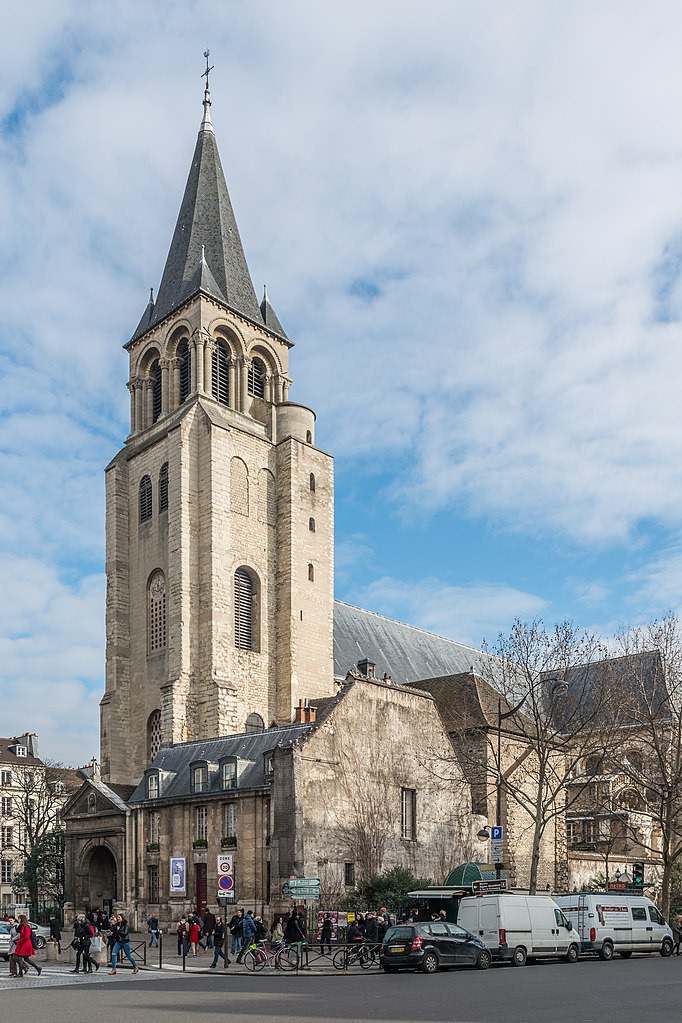
The Church of the Abbaye de Saint-Germain-des-Prés (Late 11th century) was the burial place of the first Kings of France.

The Chapelle expiatoire was built by Louis XVIII on the site of the Madeleine cemetery where the remains of Louis XVI and Marie-Antoinette were buried after their execution
.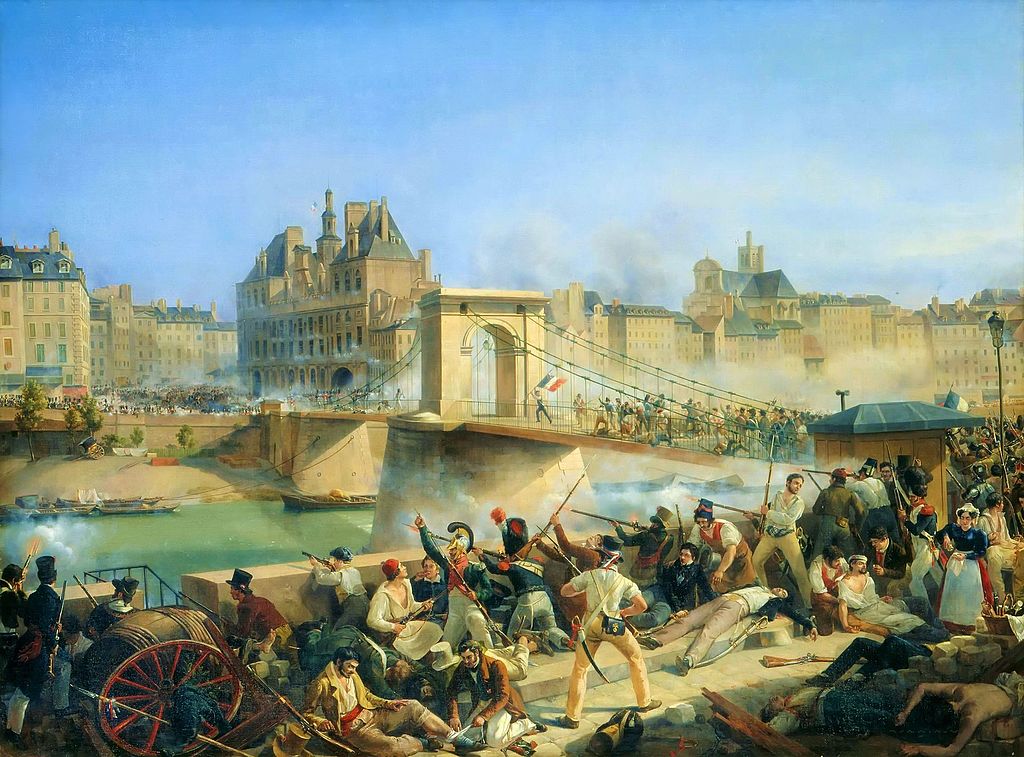
The capture of the Hôtel de VIlle during the July Revolution of 1830, which brought down the regime of Charles X. - histoire-image.org.

Giuseppe Canella, The Pont Neuf in 1832, Carnavalet Museum
Ce tableau présente un intérêt historique et iconographique relatif au Paris de 1832. On voit encore sur le Pont-Neuf les petites boutiques en hémicycle bâties par Soufflot en 1775 ; elles disparaitront sous le Second Empire. Sur le quai de l’Horloge, avant la Conciergerie, on remarque des immeubles qui seront absorbés par les agrandissements du Palais de Justice. Les « Bains du Pont-Neuf » occupent la pointe de l’ile.
François Dubois, 1836, Carnavalet Museum. A crowd of 200,000 people watched as the Luxor Obelisk was hoisted in the center of the Place de la Concorde on 25 October 1836.

Pierre-Auguste Renoir, Bal du moulin de la Galette, 1876, Musée d'Orsay, showed a Sunday afternoon dance in Montmartre. Paris became the birthplace of
modern art during the Belle Époque
.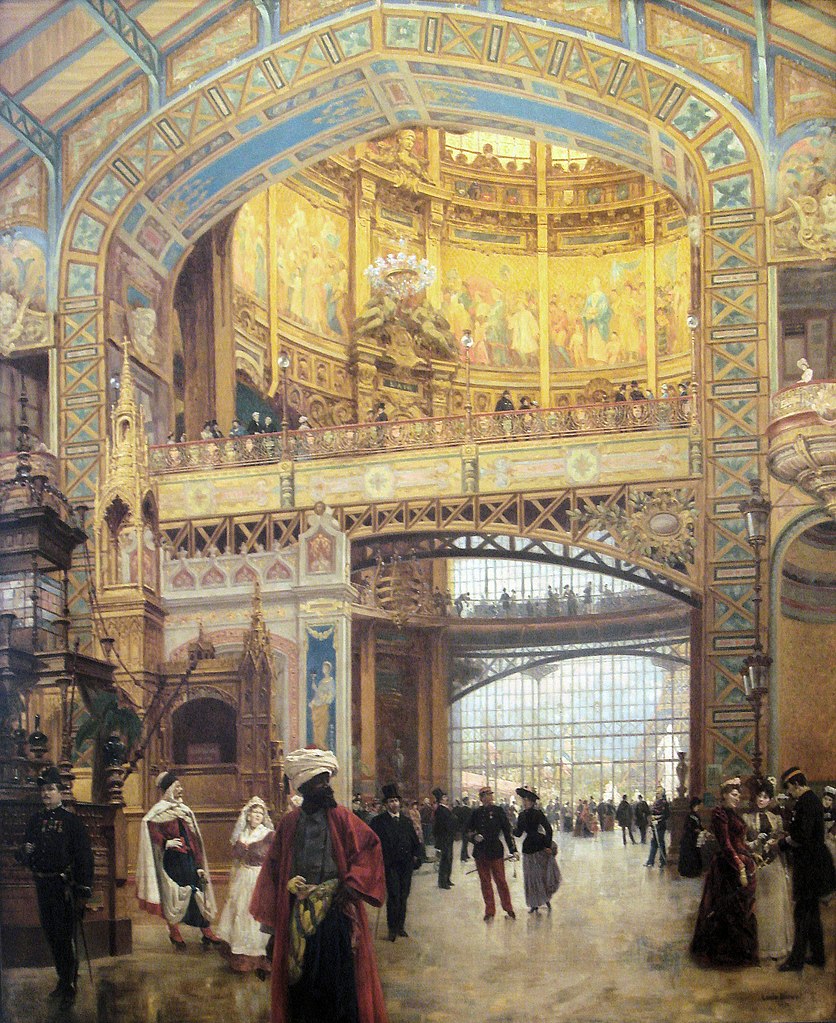
Inside the Gallery of Machines at the 1889 Exposition Universelle.

1900 ExpositionVue panoramique de l'exposition universelle de 1900.Par Lucien Baylac (1851–1913
A Trip Through Paris, France in late 1890s / Un voyage à travers Paris, 1890
)
German soldiers parade on the Champs Élysées in June 1940

On 26 August 1944, General Charles de Gaulle leads the parade celebrating the liberation of Paris the previous day.
The Liberation of Paris, 25 - 26 August 1944 General Charles de Gaulle and his entourage set off from the Arc de Triumphe down the Champs Elysees to Notre Dame
for a service of thanksgiving following the city's
liberation in August 1944

 -Statue of Marianne at the Place de la République à Paris
-Statue of Marianne at the Place de la République à Paris
The Place de la République (formerly known as the Place du Château d'Eau)is a square in Paris, located on the border between the 3rd, 10th and 11th arrondissements. The square has an area of 3.4 ha (8.4 acres). It is named after the French Republic and was called the Place du Château-d'Eau until 1879. The Métro station of République lies beneath the square.
The square was originally called the Place du Château d'Eau, named after a huge fountain designed by Pierre-Simon Girard and built on the site in 1811. La Bédollière wrote that the water came from la Villette and that the fountain was "superb" in character. In 1867, Gabriel Davioud built a more impressive fountain in the square, which (like the first fountain) was decorated with lions. The square took its current shape as part of Baron Hausmann's vast renovation of Paris.Haussmann also built new barracks on the cities, to garrison troops useful in times of civil unrest.
At the center of the Place de la République is a 31 feet (9.4 m) bronze statute of Marianne, the personification of the French Republican, "holding aloft an olive branch in her right hand and resting her left on a tablet engraved with Droits de l'homme."The statue sits atop a monument which is 75 feet (23 m) high.Marianne is surrounded with three statutes personifying liberty, equality, and fraternity, the values of the French Republic. These statutes also evoke the three medieval theological virtues.Also at the base is a lion guarding a depiction of a ballot box. The monument has been described as "an ordinary one, acceptable to a committee in the 1880s and inoffensively unarresting today."
The monument was created by brothers Léopold and Charles Morice. Leopold executed the sculptural segments, while Charles executed the architectural segments.The monument was chosen as part of an art competition announced in early 1879 by the Paris City Council, which sough to create a "Monument to the French Republic" in honor of the 90th anniversary of the French Revolution, to be erected on the Place de la République. The Morice statute was chosen by the jury, but a "vociferous minority opinion among jury members claimed precedence for the second prize"—the submission of Jules Dalou, who had just returned from exile in England. Dalou's statute, which was completely different in style, impressed the jury so much that it was decided in early 1880 to erect his monument to the Republic on the adjacent Place de la Nation.Two inauguration ceremonies for the Morice monument took place, the first on 14 July 1880 with a gypsum model, and the second on 14 July 1883 with the final version in bronze. The monument replace the second fountain.
Paris mayor Bertrand Delanoë had made a renovation of the Place de la République one of his campaign promises in the 2008 campaign for re-election. The project involved the transformation of the square from a "glorified roundabout" into a pedestrian zone, with 70% of the square's 3.4 hectares and surroundings roads being reserved for pedestrians.The Paris City Council allocated twelve million euros for renovating the square in 2010, and the project began the same year. The project was completed in 2013. The total cost of the project was 20.4 GBPU, about 5 million GBP over-budget. The renovation was a finalist for the European Prize for Urban Public Space.The pedestrian area now occupies "some two hectares in the sunniest part on the north-eastern side" while the "other third, to be used by vehicular traffic, is the shadier part on the south-western side." The statute of Marianne was cleaned of graffiti and footprints as part of the renovations.
After terrorist attacks against France in January 2015, crowds gathered in the square to mourn and express solidarity against the threat of Islamic extremism.The French Interior Ministry estimated that as many as 1.6 million people participated, making it the largest demonstration in modern French history. Crowds again rallied on the Place de la République following the November 2015 Paris attacks
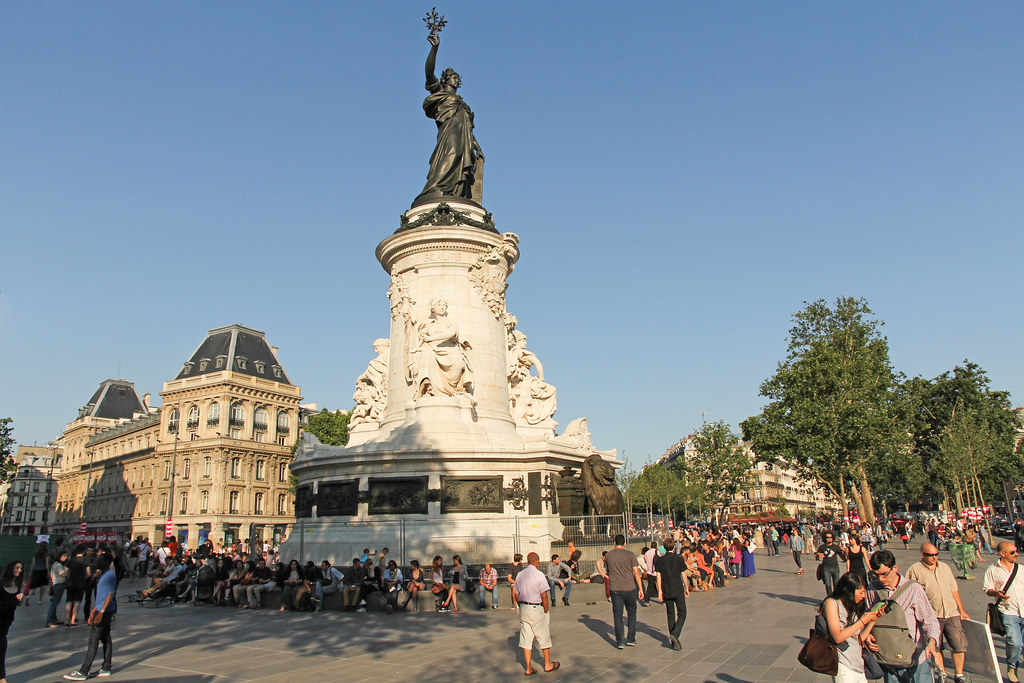
Place de la République - Paris (France)

Manifestation place de la République
 Sur décision de la Maire de Paris, l'illumina
Sur décision de la Maire de Paris, l'illumina
As requested by the Mayor of Paris, the Eiffel Tower will still be lit in the colors of the French flag from nightfall to 1:00 am until November 25th , 2015 included.
.
Anti-terrorism demonstration on Place de la Republique after the Charlie Hebdo shooting (11 January 2015)Place de la République, 18h50, une foule silencieuse
 -On Nov.22-2015_Celine Dion brings American Music Awards to tears by singing haunting Edith Piaf love song ‘Hymne a L'Amour’ in tribute to Paris.
-On Nov.22-2015_Celine Dion brings American Music Awards to tears by singing haunting Edith Piaf love song ‘Hymne a L'Amour’ in tribute to Paris.
Celine Dion brought the theater to tears at the American Music Awards as she performed a tribute to the victims of the terror attacks in Paris earlier this month.
The French-Canadian sang Edith Piaf's Hymne a l'Amour as a montage showing of Paris landmarks, including the the Louvre and the Arc de Triomphe, and the French capital uniting in the wake of the attacks, played behind her.
Several audience members at at the Microsoft Theatre in Los Angeles, California, were visibly moved as Celine sang the emotional French classic in honour of the 130 people who died in the attacks on November 13,2015.


As requested by the Mayor of Paris, the Eiffel Tower will still be lit in the colors of the French flag from nightfall to 1:00 am until November 25th , 2015 included.
-On Nov.22-2015_Celine Dion brings American Music Awards to tears by singing haunting Edith Piaf love song ‘Hymne a L'Amour’ in tribute to Paris.
Celine Dion brought the theater to tears at the American Music Awards as she performed a tribute to the victims of the terror attacks in Paris earlier this month.
The French-Canadian sang Edith Piaf's Hymne a l'Amour as a montage showing of Paris landmarks, including the the Louvre and the Arc de Triomphe, and the French capital uniting in the wake of the attacks, played behind her.
Several audience members at at the Microsoft Theatre in Los Angeles, California, were visibly moved as Celine sang the emotional French classic in honour of the 130 people who died in the attacks on November 13,2015.
-LIRE :27/11/2015_François Hollande a rendu hommage aux 130 victimes LE FIGARO.
Paris is home to the association football club Paris Saint-Germain FC and therugby union club Stade Français. The 80,000-seat Stade de France, built for the 1998 FIFA World Cup, is located in Saint-Denis. Paris hosts the annual French Open Grand Slam tennis tournament on the red clay of Roland Garros. Paris played host to the 1900 and 1924 Summer Olympics, the 1938 and 1998 FIFA World Cup, and the 2007 Rugby World Cup. The city is a major rail, highway, and air-transport hub, served by the two international airports Paris-Charles de Gaulle and Paris-Orly. Opened in 1900, the city's subway system, the Paris Métro, serves 5.23 million passengers daily. Paris is the hub of the national road network, and is surrounded by three orbital roads: the Boulevard Périphérique, the A86 motorway, and the Francilienne motorway in the outer suburbs.
-VIDEO:Paris, France
Travel video about destination France.
France is a country with a long and dramatic history. A country of unique flair and picturesque old towns, fortresses and castles and also a country of beautiful landscapes.Today Paris is one of the most beautiful cities in the world. First established by the Celts, next used strategically by the Romans and then the domain of the Sun King. Paris is not a city but a feeling of joie de vivre! Les Champs Elysees is the French metropolis’ magnificent avenue and surely one of the most beautiful in the world, with wide boulevards, shady corners and large volumes of traffic. For more than a century the members of the French court languished in Versailles where incredible pageantry and opulence dominated and the king celebrated in majestic style. A hundred hectares of ingenious garden design with a strict symmetry of wide star-shaped garden paths that seem to be without end. With its historic buildings, the eighty metre high granite mound of Le Mont-Saint-Michel is like something from a fairy tale. Due to its unique location and architectural splendour this picturesque village is often referred to as the Wonder Of The Occident. The Emerald Coast is a world of foaming white surf and dramatic cliffs. Saint Malo is the proud and solemn “Town Of Corsairs” as the yacht harbour of today once contained pirate ships. The historic centre of Nice, Vielle Ville, has maintained its charm and boasts the most well displayed fish market on the whole Cote D`Azur and a fruit and flower market that each day offers fresh produce and satisfies all the requirements of its most demanding customers. This is a journey to many corners of France - a fascinating journey not to be missed!
-VIDEO:PARIS , FRANCE - A WALKING TRAVEL TOUR - HDFrance is a country with a long and dramatic history. A country of unique flair and picturesque old towns, fortresses and castles and also a country of beautiful landscapes.Today Paris is one of the most beautiful cities in the world. First established by the Celts, next used strategically by the Romans and then the domain of the Sun King. Paris is not a city but a feeling of joie de vivre! Les Champs Elysees is the French metropolis’ magnificent avenue and surely one of the most beautiful in the world, with wide boulevards, shady corners and large volumes of traffic. For more than a century the members of the French court languished in Versailles where incredible pageantry and opulence dominated and the king celebrated in majestic style. A hundred hectares of ingenious garden design with a strict symmetry of wide star-shaped garden paths that seem to be without end. With its historic buildings, the eighty metre high granite mound of Le Mont-Saint-Michel is like something from a fairy tale. Due to its unique location and architectural splendour this picturesque village is often referred to as the Wonder Of The Occident. The Emerald Coast is a world of foaming white surf and dramatic cliffs. Saint Malo is the proud and solemn “Town Of Corsairs” as the yacht harbour of today once contained pirate ships. The historic centre of Nice, Vielle Ville, has maintained its charm and boasts the most well displayed fish market on the whole Cote D`Azur and a fruit and flower market that each day offers fresh produce and satisfies all the requirements of its most demanding customers. This is a journey to many corners of France - a fascinating journey not to be missed!
-VIDEO :Métronome Histoire de France
-VIEW :History of Paris

Paris in 1763, by Nicolas-Jean-Baptiste Raguenet, A View of Paris from the Pont Neuf, Getty Museum
Horse-drawn carriages and strolling couples make their way across the Pont Neuf, one of the oldest bridges in Paris. Boats are tied up on both sides of the Seine River, a heavily traveled thoroughfare. In the center, behind an iron fence, stands an equestrian statue of Henri IV. On the right bank of the river is the Louvre, the national museum and art gallery of France. The dome of the Hôtel des Invalides can be seen on the left bank in the distance. Jean-Baptiste Nicolas Raguenet specialized in views of Paris and owned a small shop for their sale in the rue de la Colombe on the Ile de la Cité. This view of Paris in the 1700s and its companion piece, View of Paris with the Ile de la Cité, were probably painted for an English patron, Lord Holland.

Pierre-Antoine Demachy. The Festival of the Supreme Being, held on 8 June 1794 on the Champs de Mars, was an official celebration of Cult of Reason presided over by Robespierre. On July 27, he was arrested and sent to the guillotine, ending the Reign of Terror.
-VIDEO :La Sainte-Chapelle et Son Histoire
-VIDEO :Sainte Chapelle et Conciergerie

-VIDEO :Reconstitution 3D de la Sainte-Chapelle et du palais royal de la Cité au XIVème siècle
Sainte-Chapelle, the chapel of the former royal palace on the Île de la Cité, flooded by light through the stained glass windows, is a masterpiece of the Gothic style. (13th century)-VIDEO :Sainte Chapelle: Glorious Fruit of the Middle Ages
-VIDEO :La Sainte-Chapelle, par la volonté de Saint Louis (Arte 2014 FR HD)
En 1248, le roi Louis IX fit édifier à Paris et à son usage quasi exclusif une chapelle afin d’abriter la Sainte Couronne d’épines de Jésus crucifié. Chef-d’oeuvre de l’art gothique, la Sainte-Chapelle servit surtout de catalyseur religieux pour son peuple qui vit dans ce roi couronné à 12 ans un protecteur et un rassembleur.
PARIS EN BREF
Plus de 9 millions d'habitants avec la banlieue
La ville couvre 105 km², et avec la banlieue environ 2 000km²
La ville est divisée en 20 arrondissements.
Un peu d’histoire :
En 52 avant J.C., Lutèce est conquise par les Romains. Au troisième siècle au moment des invasions germaniques, la ville se replie dans l'île de la cité et prend le nom de Paris. En 451 Paris résiste aux Uns. Les Francs en font leur résidence au VIème siècle. En 857 Les Normands incendient la ville mais le comte Eudes, ancêtre des Capétiens, leur résiste.
Visiter Paris : En tant que 1ère destination touristique mondiale, la France accueille chaque année quelques 80 millions de touristes étrangers. La capitale du pays est très fréquentée et propose de nombreux musées,
-VIDEO :Paris (France) Vacation Travel Video Guide
The Arc de Triomphe de l'Étoile is one of the most famous monuments in Paris. It stands in the centre of the Place Charles de Gaulle (originally named Place de l'Étoile), at the western end of the Champs-Élysées. It should not be confused with a smaller arch, the Arc de Triomphe du Carrousel, which stands west of the Louvre. The Arc de Triomphe (in English: "Triumphal Arch") honours those who fought and died for France in the French Revolutionary and the Napoleonic Wars, with the names of all French victories and generals inscribed on its inner and outer surfaces. Beneath its vault lies the Tomb of the Unknown Soldier from World War I.
The Arc de Triomphe is the linchpin of the historic axis (Axe historique) – a sequence of monuments and grand thoroughfares on a route which goes from the courtyard of the Louvre, to the Grande Arche de la Défense. The monument was designed by Jean Chalgrin in 1806, and its iconographic program pitted heroically nude French youths against bearded Germanic warriors in chain mail. It set the tone for public monuments, with triumphant patriotic messages.
The monument stands 50 metres (164 ft) in height, 45 m (148 ft) wide and 22 m (72 ft) deep. The large vault is 29.19 m (95.8 ft) high and 14.62 m (48.0 ft) wide. The small vault is 18.68 m (61.3 ft) high and 8.44 m (27.7 ft) wide. Its design was inspired by the Roman Arch of Titus. The Arc de Triomphe is built on such a large scale that, three weeks after the Paris victory parade in 1919 (marking the end of hostilities in World War I), Charles Godefroy flew his Nieuport biplane through it, with the event captured on newsreel.
It was the tallest triumphal arch in existence until the completion of the Monumento a la Revolución in Mexico City in 1938, which is 67 metres (220 ft) high. However, the Arch of Triumph in Pyongyang, completed in 1982, is modelled on the Arc de Triomphe although slightly taller at 60 m (197 ft).



Beneath the Arc is the Tomb of the Unknown Soldier from World War I. Interred here on Armistice Day 1920, it has the first eternal flame lit in Western and Eastern Europe since the Vestal Virgins' fire was extinguished in the fourth century. It burns in memory of the dead who were never identified (now in both world wars).
A ceremony is held at the Tomb of the Unknown Soldier every 11 November on the anniversary of the armistice signed between France and Germany in 1918. It was originally decided on 12 November 1919 to bury the unknown soldier's remains in the Panthéon, but a public letter-writing campaign led to the decision to bury him beneath the Arc de Triomphe. The coffin was put in the chapel on the first floor of the Arc on 10 November 1920, and put in its final resting place on 28 January 1921. The slab on top carries the inscription ICI REPOSE UN SOLDAT FRANÇAIS MORT POUR LA PATRIE 1914–1918 ("Here lies a French soldier who died for the fatherland 1914–1918").
In 1961, President John F. Kennedy and First Lady Jacqueline Kennedy of the United States paid their respects at the Tomb of the Unknown Soldier, accompanied by French President Charles de Gaulle. After the 1963 assassination of President Kennedy, Mrs Kennedy remembered the eternal flame at the Arc de Triomphe and requested that an eternal flame be placed next to her husband's grave at Arlington National Cemetery in Virginia. President Charles de Gaulle went to Washington to attend the state funeral, and witnessed Jacqueline Kennedy lighting the eternal flame that had been inspired by her visit to France.



Crowds of French patriots line the Champs Elysees to view Free French tanks and half tracks of General Leclerc's 2nd Armored Division passes through the Arc du Triomphe, after Paris was liberated on August 26, 1944. Among the crowd can be seen banners in support of Charles de Gaulle.
.

2013_06_14_The Arc de Triomphe, Paris.
The Arc de Triomphe de l'Étoile is one of the most famous monuments in Paris.


2013_06_14_ The Avenue des Champs-Ély

2013_06_14_ Louis Vuitton Headquarters in Paris.

2013_06_14 The Paris metro.
- France-Seine River Cruise+Paris by Night
-La Ville Lumière vue du ciel_by Drone Cam_Aug 29, 2016 :
-VIDEO :HD Seine Cruise Clips
2009_06_04-Seine River Cruise_France_Seine River Cruise on the Bateaux
Mouches.
Mouches.

-VIDEO :Paris tu m'as pris dans tes bras_Enrico Macias-(1964)


La PLUS PETITE MAISON de Paris mesure 1,10m de large et 5,15m de haut, vous la trouverez au 39 rue du Château d’eau dans le 10ème,
-VIDEO :◄ Petit Palais, Paris [HD] ►
It was built for the 1900 Exposition Universelle (universal exhibition), it now houses the City of Paris Museum of Fine Arts (Musée des beaux-arts de la ville de Paris). The Petit Palais is located across from the Grand Palais on Avenue Nicolas II, today Avenue Winston-Churchill. The other façades of the building face the Seine and Avenue des Champs-Elysees.
The Petit Palais is one of the 14 museums of the City of Paris, that have been incorporated since January 1, 2013 in the public corporation Paris Musées.

Petit Palais facade

La Seine et ses affluents (The Seine and its tributaries).

Petit Palais hall

French: Les Quatre Saisons
The Four Seasons

Entrance of the Petit Palais, a Parisian palace built in 1900 for the Universal Exhibition. Avenue Winston Churchill, Paris.

Pont Alexandre III – the most spectacular bridge in Paris
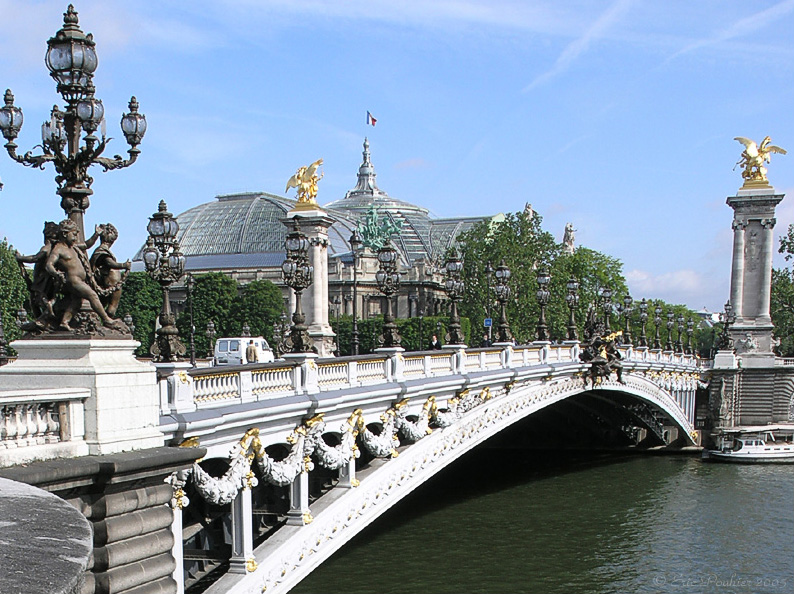
The Pont Alexandre III is a deck arch bridge that spans the Seine in Paris.
It connects the Champs-Élysées quarter with those of the Invalides and Eiffel Tower.
The bridge is widely regarded as the most ornate, extravagant bridge in the city.
It is classified as a French Monument historique,built between 1896 and 1900.
-VIDEO :◄ Pont Alexandre III, Paris [HD] ►

The Alexandre III bridge, in Paris. On the left, Les Invalides is visible.Photo by Dimitri Destugues
The Grand Palais des Champs-Élysées, commonly known as the Grand Palais (English: Great Palace), is a large historic site, exhibition hall and museum complex located at the Champs-Élysées in the8th arrondissement of Paris, France. Construction of the Grand Palais began in 1897 following the demolition of the Palais de l'Industrie (Palace of Industry) as part of the preparation works for theUniversal Exposition of 1900, which also included the creation of the adjacent Petit Palais and Pont Alexandre III.
The structure was built in the style of Beaux-Arts architecture as taught by the École des Beaux-Arts of Paris. The building reflects the movement's taste for ornate decoration through its stone facades, the formality of its floor planning and the use of techniques that were innovative at the time, such as its glass vault, its structure made of iron and light steel framing, and its use of reinforced concrete
The Alexandre III bridge, in Paris. On the left, Les Invalides is visible.Photo by Dimitri Destugues
The Grand Palais des Champs-Élysées, commonly known as the Grand Palais (English: Great Palace), is a large historic site, exhibition hall and museum complex located at the Champs-Élysées in the8th arrondissement of Paris, France. Construction of the Grand Palais began in 1897 following the demolition of the Palais de l'Industrie (Palace of Industry) as part of the preparation works for theUniversal Exposition of 1900, which also included the creation of the adjacent Petit Palais and Pont Alexandre III.
The structure was built in the style of Beaux-Arts architecture as taught by the École des Beaux-Arts of Paris. The building reflects the movement's taste for ornate decoration through its stone facades, the formality of its floor planning and the use of techniques that were innovative at the time, such as its glass vault, its structure made of iron and light steel framing, and its use of reinforced concrete

Panoramique Grand Palais à Paris .

Une partie du toit du Grand Palais côté Seine à Paris, montrant notamment le groupe sculpté L'Harmonie triomphant de la Discorde, bronze de Georges Récipon
English: A part of the roof of the Grand Palais (side near the Seine), showing the bronze group Harmony triumphing over Discord, by Georges Récipon

“L'Immortalité devançant le Temps” (Immortality outstripping Time) Quadriga by Georges Récipon, Grand Palais Paris
-VIDEO :◄ Grand Palais, Paris [HD] ►
-VIEW :LE DÎNER EN BLANC : LE PIC-NIC FANCY

-VIDEO :Le Dîner en Blanc de PARIS 2014
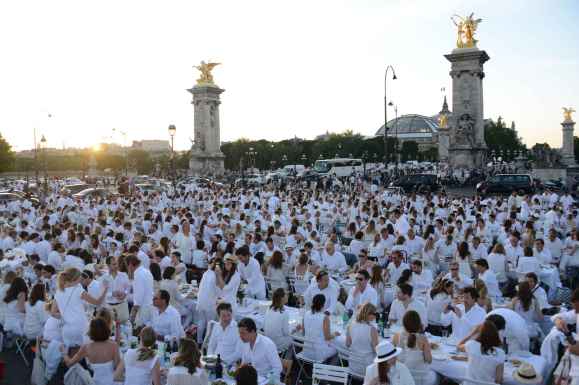
13 000 dîneurs investissaient six ponts de la capitale : le pont Alexandre III, le pont d’Iéna, la Passerelle Solférino, le pont de la Concorde, la passerelle Debilly et le Pont de l’Alma.
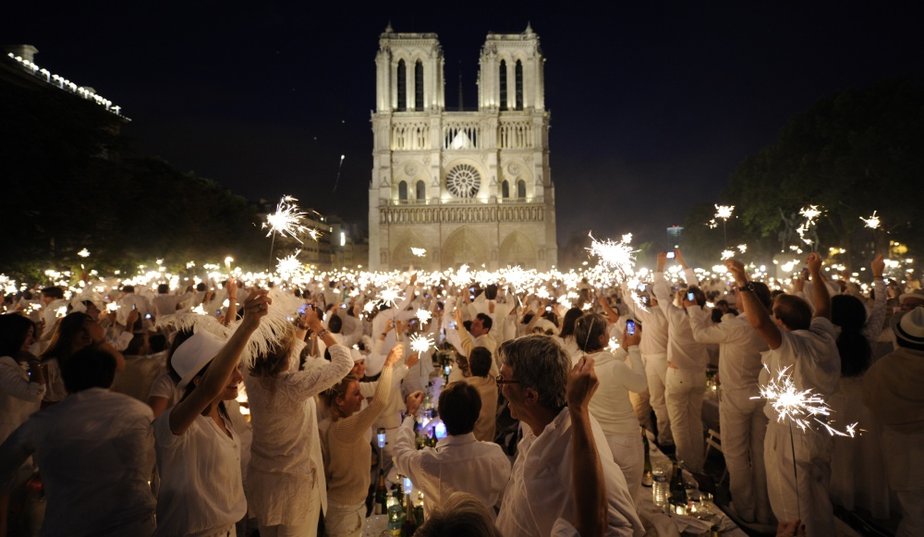
A 23 heures, des bougies pétillantes sont distribuées…
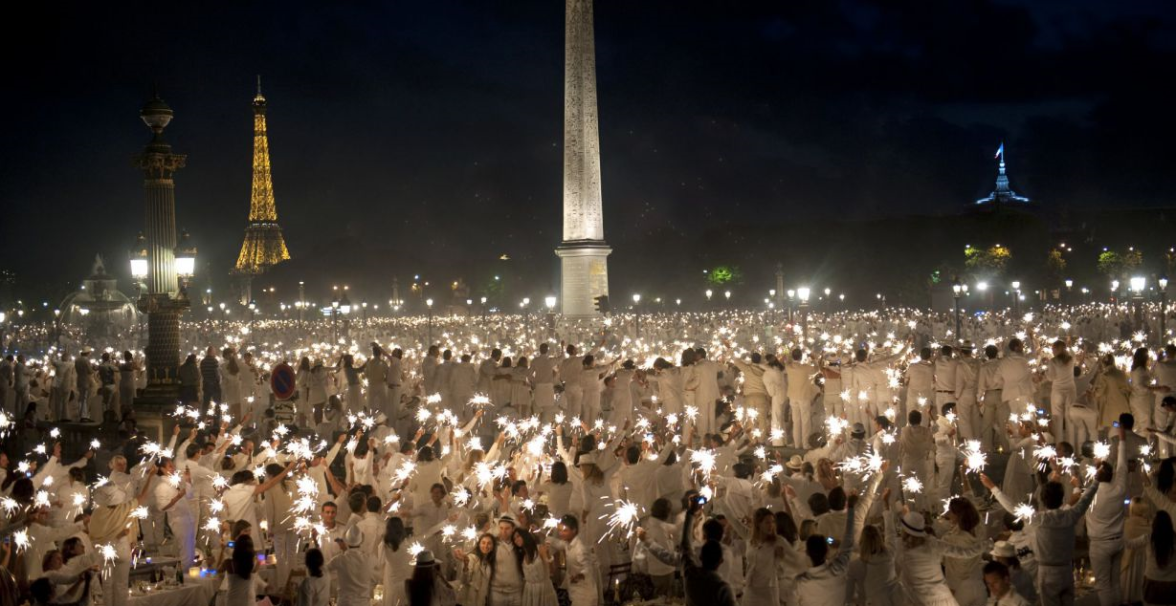
et sont allumées en même temps par les milliers de pic-niqueurs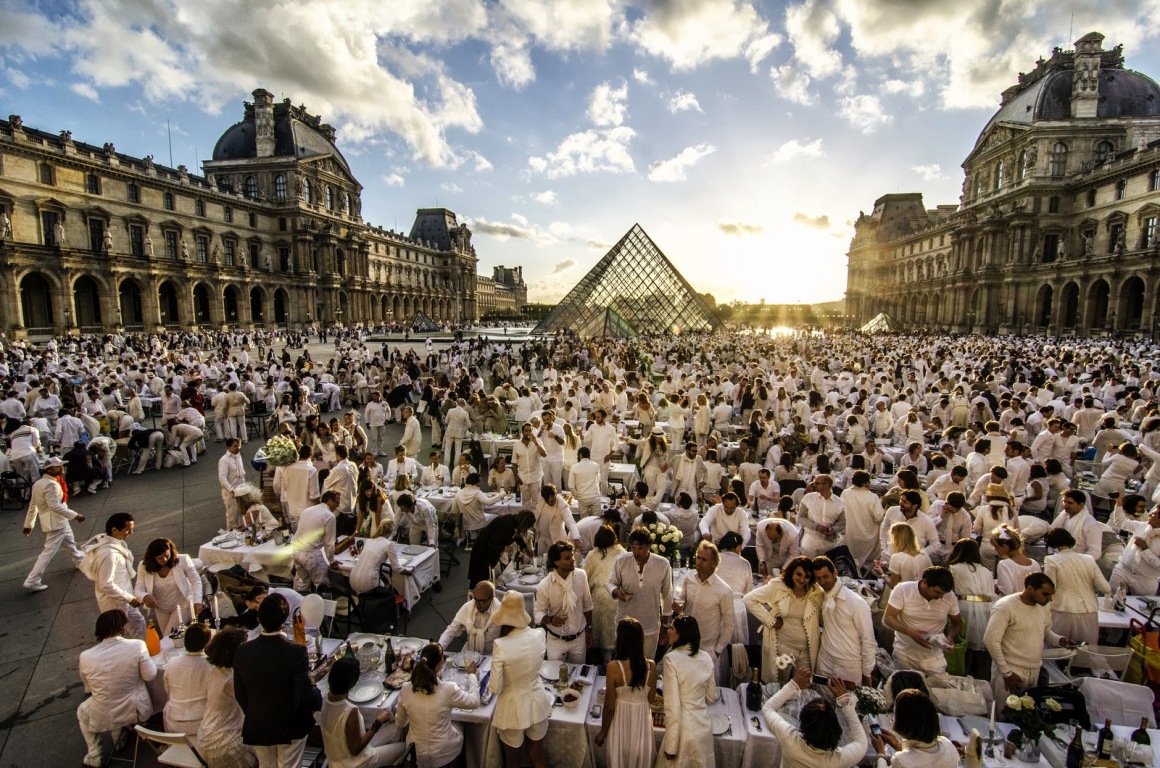
This 1/4 scale Statue of Liberty stands on an island, much like our Statue of Liberty on Liberty Island (then called Bedloe's Island) in New York Harbor, a gift from the people of France to the United States.
-VIEW : Il y a 5 Statues de la Liberté à Paris !_Vous connaissez celle de New-York qui fait 46,05 mètres (93 mètres socle inclus), mais savez-vous qu’il y a pas moins de 5 répliques originales de la Statue de la Liberté à Paris ? Si, si on vous jure !
-VIDEO :Paris • Sightseeing Cruise on the Seine River_July 2014

The Eiffel Tower (French: La Tour Eiffel is an iron lattice tower located on the Champ de Mars in Paris_2009_06_04-Seine River Cruise

Opera House

The Galeries Lafayette_

-Dinner at
Histoire
Un restaurant centenaire
Restaurant parisien centenaire influencé par l'opéra « Les Noces de Jeannette »
Le restaurant Les Noces de Jeannette est un lieu marqué par la richesse de son passé. Rénové, il garde l'attrait et le charme du Paris du 19e siècle. Sa structure, ses meubles et sa décoration vous plonge dans cette époque qui a influencé la vision de la capitale de nos jours, aussi bien en France qu'à l'étranger.
La première enseigne du restaurant fut Poccardi, célèbre restaurant du début du siècle.
L'établissement prit ensuite le nom " Les Noces de Jeannette ", opéra comique en un acte de Victor Massé, qui, créé en 1853, fut joué des centaines de fois en lever de rideau, salle Favart, de l'autre côté de la rue.
Le jour de ses noces avec Jeannette, Jean s'enfuit. L'air de la romance sur lequel Jeannette chante en raccommodant l'habit déchiré de Jean, " Cours mon aiguille dans la laine ", est resté populaire.
Les époux se réconcilient enfin sur le célèbre air du rossignol, ainsi nommé car la flûte imite le chant de l'oiseau :
|
-VIDEO :Les Noces de Jeannette - Une Demoiselle en Loterie - Barokopera Amsterdam


2009-06-04_-Dinner @ " Les Noces de Jeannette "


2009_06_04_Dinner in Paris _France
Escargot ( French for snail) is a dish of cooked land snails, usually served as an appetizer in Portugal, Spain and in France. Escargot is a typical dish in the Catalan region of Spain. The word escargot is also sometimes applied to the living snails of those species which are commonly eaten in this way.
Not all species of land snail are edible, and many are too small to make it worthwhile to prepare and cook them. Even among the edible species, the palatability of the flesh varies from species to species. In France, the species Helix pomatia is most often eaten. The "petit-gris" Helix aspersa is also eaten, as is Helix lucorum. Several additional species, such as Elona quimperiana, are popular in Europe; see heliciculture.

-VIDEO :L'escargot

Plate of escargot with tongs and fork, taken in Bordeaux FRANCE
In French culture, the snails are typically purged, killed, removed from their shells, and cooked (usually withgarlic butter, chicken stock or wine), and then placed back into the shells with the butter and sauce for serving. Additional ingredients may be added, such as garlic, thyme, parsley and pine nuts. Special snail tongs (for holding the shell) and snail forks (for extracting the meat) are also normally provided, and they are served on indented metal trays with places for six or 12 snails.
In Maltese cuisine, snails (Maltese: bebbux) of the petit gris variety are simmered in red wine or ale with mint, basil and marjoram. The snails are cooked, and served in their shells.
Escargot de Bourgogne

2009_06_04_Dinner in Paris _France

BRIGITTE BARDOT



A Chateaubriand
Chateaubriand, the man, was François-René, Vicomte de Chateaubriand, (1768-1848); a writer, a gourmand and a politician. , first the steak, the steak called a Chateaubriand.
The Chateaubriand steak.
The Chateaubriand is a cut from best and thickest part of the tenderloin, the fillet. This is the same cut used for a Tournedos Rossini but it is, or it certainly should be, even thicker. The Chateaubriand is steak/roast, the description is sometimes disputed, that is at least 7 - 10 cms high; a small Chateaubriand will be 300 gram steak
-Fromage (Cheese)
An avid cheese lover, Brillat-Savarin remarked: "A dessert without cheese is like a beautiful woman with only one eye."
"Un dessert sans fromage est une belle à qui il manque un œil"
Brillat-Savarin (Jean-Anthelme)
Né le 1er avril 1755 à Belley et mort le 1er février 1826 à Paris, Jean Anthelme Brillat-Savarin, magistrat français et gastronomes réputé français fut, toute sa vie, un épicurien. Belley doit une renommée à son fils illustre, et les touristes s'y rendent volontiers, durant l'été, depuis Aix et Chambéry. Brillat-Savarin y possède sa statue, sa rue, on montre la gentilhommière de sa famille.
Le gâteau Brillat-Savarin est un hommage à son oeuvre tout comme le fromage qui porte également son nom
Le gâteau Brillat-Savarin est un hommage à son oeuvre tout comme le fromage qui porte également son nom
Few things are as embedded in French food culture as fromage, and this humble plate is actually the first step to eating cheese like a French person. “A meal without cheese is like a beautiful woman with only one eye,” opined the well-known gastronome Brillat-Savarin, and all of those plates, all across the Hexagon, prove how deeply the French take that maxim to heart.

Camembert
Marie Harel created the original Camembert cheese from raw milk in Normandy, France in 1791. Today, however, a very small percentage of producers make cheese from raw milk with the same process as Marie Harel would have used. Those who produce cheese using Marie Harel's method, can legally call their cheese Camembert Normandie under the AOC guidelines. However, the production of Camembert cheese has now transcended the AOC designation. Very good varieties of Camembert cheese made from pasteurised milk can be found in Normandy today. The best of them is the Camembert Le Châtelain.
The fresh Camembert cheese is bland, hard and crumbly in texture. Young Camembert has a milky and sweet taste. As the cheese matures it forms a smooth, runny interior and a white bloomy rind that is typical to Camenbert cheese. It has a rich, buttery flavour. The rind is bloomy white caused by a white fungus, called penicillium candidum.The rind is meant to be eaten with the cheese.
This cheese is best paired with a light red wine such as Beaujolais, Chenin Blanc, St Emilion, St Estephe or traditionally a glass of Normandy cider.
"The pleasure of the table belongs to all ages, to all conditions, to all countries, and to all areas; it mingles with all other pleasures, and remains at last to console us for their departure."
"LE PLAISIR DE LA TABLE EST DE TOUS LES ÂGES, DE TOUTES LES CONDITIONS,
DE TOUS LES PAYS ET DE TOUS LES JOURS ;
IL PEUT S'ASSOCIER À TOUS LES AUTRES PLAISIRS,
ET RESTE LE DERNIER POUR NOUS CONSOLER DE LEUR PERTE".

Title page of "La Physiologie du Goût" ("The Physiology of Taste") by French gastronome Jean Anthelme Brillat-Savarin (1755-1826) with a portrait of the author. 1848 edition.

Brillat-Savarin Jean-Anthelme
Brillat-Savarin Jean-Anthelme
DE TOUS LES PAYS ET DE TOUS LES JOURS ;
IL PEUT S'ASSOCIER À TOUS LES AUTRES PLAISIRS,
ET RESTE LE DERNIER POUR NOUS CONSOLER DE LEUR PERTE".

Title page of "La Physiologie du Goût" ("The Physiology of Taste") by French gastronome Jean Anthelme Brillat-Savarin (1755-1826) with a portrait of the author. 1848 edition.

Crème brûlée also known as burnt cream, crema catalana, or Trinity cream is a dessert consisting of a rich custard base topped with a contrasting layer of hard caramel. It is normally served at room temperature. The custard base is traditionally flavored with vanilla, but can have a variety of other flavorings.
Crème brûlée flambée
The earliest known reference to crème brûlée as it is known today appears in François Massialot's 1691 cookbook, and the French name was used in the English translation of this book, but the 1731 edition of Massialot's Cuisinier roial et bourgeois changed the name of the same recipe from "crème brûlée" to "crème anglaise". In the early eighteenth century, the dessert was called "burnt cream" in English.
In Britain, a version of crème brûlée (known locally as "Trinity Cream" or "Cambridge burnt cream") was introduced at Trinity College, Cambridge, in 1879 with the college arms "impressed on top of the cream with a branding iron", though crème brûlée itself was not invented at Cambridge. The story goes that the recipe was from an Aberdeenshire country house and was offered by an undergraduate, to the college cook, who turned it down. However, when the student became a Fellow, he managed to convince the cook to serve it
Café Les Deux Magots in Saint-Germain-des-Prés,Paris 6ème , France.
Les Deux Magots is a famous café in the Saint-Germain-des-Prés area of Paris, France. It once had a reputation as the rendezvous of the literary and intellectual élite of the city. It is now a popular tourist destination. Its historical reputation is derived from the patronage of Surrealist artists, intellectuals such as Simone de Beauvoir and Jean-Paul Sartre, and young writers, such as Ernest Hemingway. Other patrons included Albert Camus, Pablo Picasso, James Joyce, Bertolt Brecht and the American writer Charles Sutherland.
The Deux Magots literary prize has been awarded to a French novel every year since 1933.
The "Deux Magots" inside the café
-VIDEO :Paris: Regal and Intimate_(2014)
|
P A R I S

Eiffel Tower by the Seine river, Paris, 2 March 2014

The Eiffel Tower (French: La Tour Eiffel) is an iron lattice tower located on the Champ de Mars in Paris. It was named after the engineer Gustave Eiffel, whose company designed and built the tower. Erected in 1889 as the entrance arch to the 1889 World's Fair, it was initially criticised by some of France's leading artists and intellectuals for its design, but has become both a global cultural icon of France and one of the most recognizable structures in the world. The tower is the tallest structure in Paris and the most-visited paid monument in the world; 6.98 million people ascended it in 2011. The tower received its 250 millionth visitor in 2010.
The tower is 324 metres (1,063 ft) tall, about the same height as an 81-storey building. During its construction, the Eiffel Tower surpassed the Washington Monument to assume the title of the tallest man-made structure in the world, a title it held for 41 years, until the Chrysler Building in New York City was built in 1930. Because of the addition of the antenna atop the Eiffel Tower in 1957, it is now taller than the Chrysler Building by 5.2 metres (17 ft). Not including broadcast antennae, it is the second-tallest structure in France, after the Millau Viaduct.
The tower has three levels for visitors, with restaurants on the first and second. The third level observatory's upper platform is 276 m (906 ft) above the ground, the highest accessible to the public in the European Union. Tickets can be purchased to ascend by stairs or lift (elevator) to the first and second levels. The climb from ground level to the first level is over 300 steps, as is the walk from the first to the second level. Although there are stairs to the third and highest level, these are usually closed to the public and it is generally only accessible by lift.
Vue générale de l'Exposition universelle de 1889
Tableau de Georges Garen peint en 1889 intitulé « Embrasement de la Tour Eiffel pendant l’Exposition universelle de 1889


360° virtual tour of Trocadero - Tour Eiffel

2009_06_04_Eiffel Tower Paris, France.



2013_06_15_Eiffel Tower Paris, France.


-VIDEO :Eiffel Tower - Paris, France

-VIDEO :Eiffel Tower in Paris, France - Going up to both floors




Place de la Concorde_In the center of the place is l'obélisque, a gift to France from Egypt in 1836. It is one of a pair of obelisks originally placed together in the city of Luxor and is well over three thousand years old. In its current setting, it supposedly serves as a sundial with lines marked in the pavement around it; I've never noticed the lines. The obelisk is flanked by two large fountains: the Fountain of the Seas and the Fountain of the Rivers, each meant to celebrate France's naval prowess. If you're brave enough to make your way on foot to the middle of the place, you can see engravings on the base of the obelisk that depict its transport from Egypt to France.
The obelisk once marked the entrance to the Luxor Temple. The Ottoman viceroy of Egypt, Mehmet Ali, offered the 3,300-year-old Luxor Obelisk to France in 1829. It arrived in Paris on 21 December 1833. Three years later, on 25 October 1836, King Louis Philippe had it placed in the center of Place de la Concorde, where a guillotine used to stand during the Revolution.
The obelisk once marked the entrance to the Luxor Temple. The Ottoman viceroy of Egypt, Mehmet Ali, offered the 3,300-year-old Luxor Obelisk to France in 1829. It arrived in Paris on 21 December 1833. Three years later, on 25 October 1836, King Louis Philippe had it placed in the center of Place de la Concorde, where a guillotine used to stand during the Revolution.
The two impressive buildings on either side of this picture are, on the left, the Hotel de Crillon, a classy high-end hotel, and on the right, the headquarters of the French Navy. Between them, at the top of the rue Royale, you can see the classical façade of the Madeleine Church.
The Place de la Concorde is one of the major public squares in Paris, France. Measuring 8.64 hectares (21.3 acres) in area, it is the largest square in the French capital. It is located in the city's eighth arrondissement, at the eastern end of the Champs-Élysées.
The Place was designed by Ange-Jacques Gabriel in 1755 as a moat-skirted octagon between the Champs-Élysées to the west and the Tuileries Garden to the east. Decorated with statues and fountains, the area was named Place Louis XV to honor the king at that time. The square showcased an equestrian statue of the king, which had been commissioned in 1748 by the city of Paris, sculpted mostly by Edmé Bouchardon, and completed by Jean-Baptiste Pigalle after the death of Bouchardon.
At the north end, two magnificent identical stone buildings were constructed. Separated by the rue Royale, these structures remain among the best examples of Louis Quinze style architecture. Initially, the eastern building served as the French Naval Ministry. Shortly after its construction, the western building became the opulent home of the Duc d'Aumont. It was later purchased by the Comte de Crillon, whose family resided there until 1907. The famous luxury Hôtel de Crillon, which currently occupies the building, took its name from its previous owners.
During the French Revolution the statue of Louis XV of France was torn down and the area renamed "Place de la Révolution". The new revolutionary government erected the guillotine in the square, and it was here that King Louis XVI was executed on 21 January 1793.

Journée du 21 janvier 1793 la mort de Louis Capet sur la place de la Révolution : présentée à la Convention nationale le 30 germinal par Helman
Other important figures guillotined on the site, often in front of cheering crowds, were Queen Marie Antoinette, Princess Élisabeth of France,Charlotte Corday, Madame du Barry, Georges Danton, Camille Desmoulins, Antoine Lavoisier, Maximilien Robespierre, Louis de Saint-Justand Olympe de Gouges.
The guillotine was most active during the last part of the "Reign of Terror", in the summer of 1794, when in a single month more than 1,300 people were executed. A year later, when the revolution was taking a more moderate course, the guillotine was removed from the square.
In 1795, under the Directory, the square was renamed Place de la Concorde as a gesture of reconciliation after the turmoil of the French Revolution. After the Bourbon Restoration of 1814, the name was changed back to Place Louis XV, and in 1826 the square was renamed Place Louis XVI. After the July Revolution of 1830 the name was returned to Place de la Concorde and has remained since.
-VIDEO : Paris in 4K _2017.
-VIDEO :
Les Rois De France - 15 siècles d'histoire_playlist.
-VIDEO : PARIS Phim - Thắng Cảnh, Kiến Trúc, Lịch Sử -- Đôi Giầy Cũ (7 tập).
-The Entire History of France in 23 Minutes:








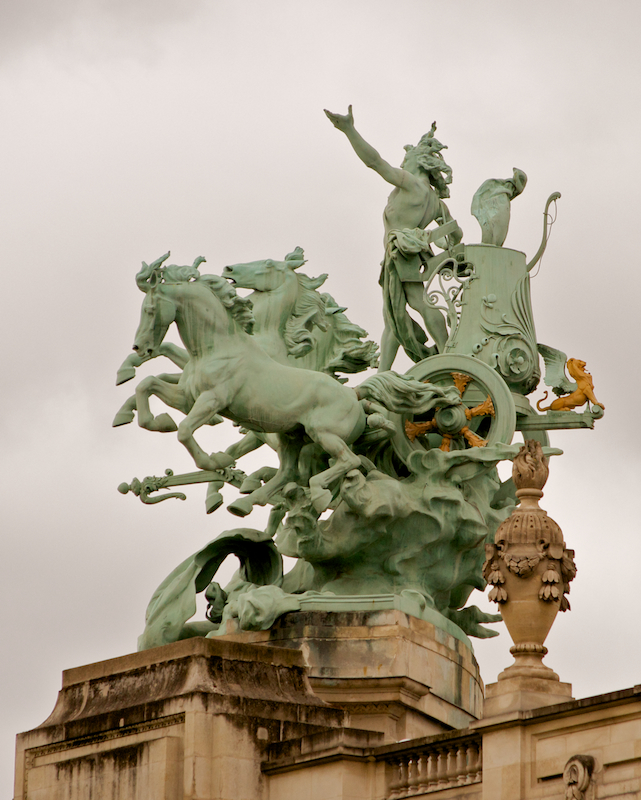
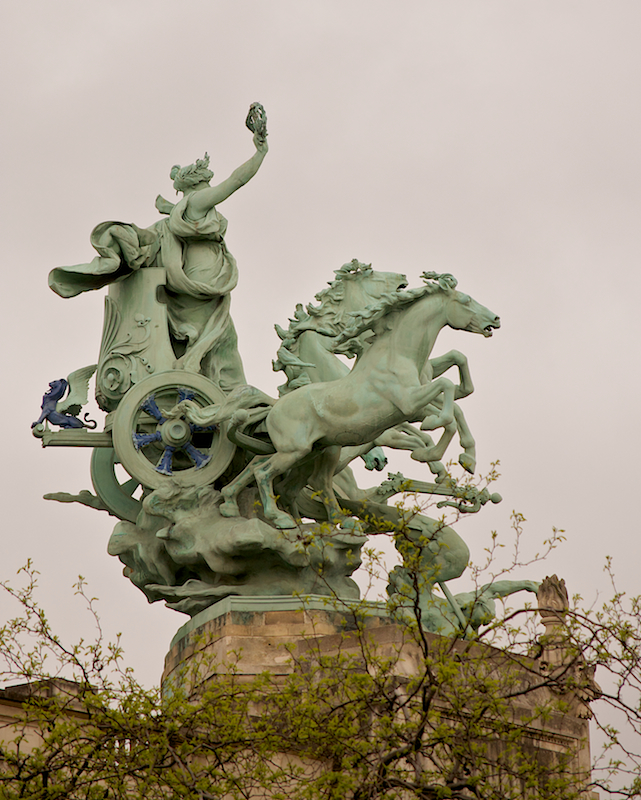


No comments:
Post a Comment